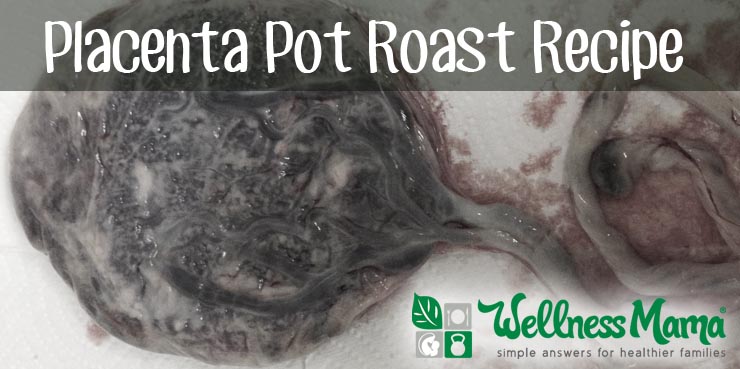Today, I’m sharing an unusual recipe…
Giving birth is taxing on a woman’s body but the birthing process provides a wonderful way to replenish the hormones and iron: the placenta.
The Benefits of Consuming Placenta
So why would anyone in her right mind want to eat THAT? Glad you asked…. Wikipedia explains:
“Placentophagy (from ‘placenta’ + Greek ‘to eat;’ also referred to as placentophagia) is the act of mammals eating the placenta of their young after childbirth.
Apparently, it contains high levels of prostaglandin which stimulates involution (an inward curvature or penetration, or, a shrinking or return to a former size) of the uterus, in effect cleaning the uterus out. The placenta also contains small amounts of oxytocin which eases birth stress and causes the smooth muscles around the mammary cells to contract and eject milk.
Some research has shown that ingestion of the placenta can increase the pain threshold in pregnant rats. Rats that consumed the placenta experienced a modest amount of elevation of naturally-occurring opioid-mediated analgesia. Endogenous opioids, such as endorphin and dynorphin, are natural chemicals, related to the opium molecule, that are produced in the central nervous system. Production of these endogenous opioids is increased during the birthing process. They have the ability to raise the threshold of pain tolerance in the mother. When coupled with ingested placenta or amniotic fluid, the opioid effect on pain threshold is dramatically increased. Rats that were given meat instead of the placenta showed no increase in the pain threshold.
American Medical anthropologists at the University of South Florida and UNLV, surveyed new mothers, and found that about 3/4 had positive experiences from eating their own placenta, citing “improved mood”, “increased energy”, and “improved lactation””
This article also points out the suggested benefits:
“It is believed that consuming the placenta can:
- Help to balance your hormones
- Replenish depleted iron levels
- Assist the uterus to return to its pre-pregnancy state
- Reduce post-natal bleeding
- Increase milk production – this has been proven in a study
- Make for a happier, more enjoyable post-natal period
- Increase your energy levels”
Placenta Encapsulation
With the growing popularity, it is now possible to find people who specialize in encapsulation. In this process, the placenta is cleaned, steamed, dehydrated and ground into pills to be consumed as needed.
This process definitely makes the idea of consumption a little easier for most people, but it can get pricey and more importantly, it takes several days so mom doesn’t get the benefits for the first few critical days.
These services are definitely an option, but I’ve found an easier way to consume it for optimal benefit: Placenta Pot Roast.
This recipe allows mom to consume the placenta within 12 hours of giving birth and adds nutritious herbs and vegetables. Many women crave protein after labor and this recipe is the solution. Even better, it is simple to prepare and leftovers can be frozen to eat as needed.
Sound too crazy? It has a milder flavor than liver or other organ meats and it can usually be easily consumed once properly spiced and prepared. Most other mammals consume the placenta, we just get the benefit of adding vegetables and spices. This recipe should be consumed by the mother who has just delivered a baby and not by anyone else. The benefits of placenta consumption are for the mother only…

Placenta Pot Roast Recipe
Placenta Pot Roast Ingredients
- Fresh placenta – refrigerated immediately after birth
- 3 carrots
- 2 medium onions
- 1 pound fresh green beans
- 1 teaspoon each of garlic powder, onion powder, basil, salt, pepper and thyme
- 2 tablespoons coconut oil
Placenta Pot Roast Instructions
- Clean the placenta and carefully cut off the cord and the side that was attached to the baby, including the membrane.
- Sprinkle with the spices on either side to evenly coat.
- Place the placenta in the crock pot.
- Chop carrots and add.
- Slice onions and place on top of the placenta
- Add green beans.
- Place coconut oil on top of the onions.
- Cook on high (2 hours) or low (4 hours) until tender.
- Serve immediately or freeze to consume later.
Important Note
When making this recipe, please note that it is April 1 and this post is an APRIL FOOLS JOKE… 🙂 If you read this far, thanks for being a good sport! If you want to spread the fun (and get some interesting reactions from your friends) share this post on social media with a comment about how you’ll definitely be trying it 🙂 and tag me so I can see your post. Please don’t try this recipe as I completely made it up and have never tried placenta pot roast myself.
For the record, I have nothing against placenta consumption and had my own encapsulated to be able to try it with my last pregnancy since I’d gotten so many questions about it, but I don’t think I’d have the stomach to consume it as a pot roast 🙂
Ever consumed yours? Were you fooled by the joke or did you think it was for real? Please share below!


Leave a Reply